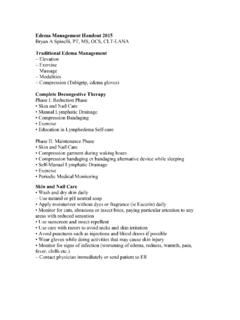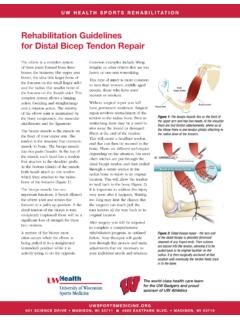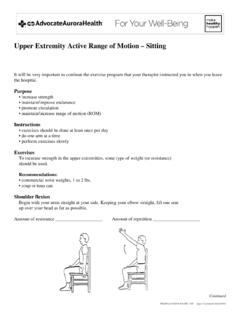Transcription of Small Joints of the Hand: Joint Mobilization: MCP, PIP ...
1 1 Joint Mobilization: Elbow, Wrist, and HandPhiladelphia Hand MeetingMonday, March 26, 2018 Jane Fedorczyk, PT, PhD, CHTF rank Fedorczyk, PT, DPTC hris Keating, PT, DPT, OCSC hristina Read, PT, DPT, CHTKen Taylor, PT, DPT, OCS Small Joints of the Hand: MCP, PIP, and DIP: distraction and glides (A/P or P/A) Concave-Convex Rule: Distal concave segment (base of P1) moves on proximal convex segment (MC head)Roll and Slide are in same directionPosterior glides to increase extensionAnterior glides to increase flexionSmall Joints of the Hand: MCP, PIP, and DIP: distraction and glides (A/P or P/A) Practical Tip #1: Perform both directions to improve MCP flexionPractical Tip #2: Not best choice for PIP flexion contracturesor profound Small Joint stiffness; value heat/stretch & Tip #3: radial/ulnar glides; just cause you can doesn t mean it has benefit; positional faults likely Tip #4:may not be best option for pain modulation;handling can be uncomfortable; tissue interface may be needed.
2 1stCMC or Basal or Trapeziometacarpal (TM) JointJoint mobilization primarily for pain modulationCMC Abduction: convex MC on concave trapeziumroll anterior, slide posteriorroll radial deviation, slide ulnar deviationCMC Flex/Ext: concave MC on convex trapeziumroll and slide in same direction like other Small jointsPosterior glides to increase extensionAnterior glides to increase flexion2 Distraction: to facilitate long axis rotation essential for pad to pad pinch Skull Rock Introduced by Jan Albrecht, OT, CHT more than a decade agoas a self-mob option for CMC Joint pain. Long axis distractioncombined with active sensory input. Elbow: 3 Articulations Ulnohumeral Radiohumeral Superior or Proximal Radioulnar JointHRUCTRHO Lock and Key Configuration Primary to StabilityArticular Configuration Adds to Stability and Creates Very Little Joint Play11 DistractionUlnohumeralRadiohumeral3 Medial or Lateral Tilt of Ulnohumeral JointMedial Tilt/GapVF = valgus forceLateral Tilt/GapVF = varus force SSVFVFP ractical Tips for Elbow Vigorous technique may create problems.
3 Nerve Irritability Tissue Reactivity Stiffness best treated with LLPS. May not be enough play to modulate pain. When using LLPS for cement elbows, Joint play likely to return before physiologic motion; use gap or tilt to or Superior Radioulnar Joint Pronation/Supination Ulna is the stable bone Radius rotates about the ulna Radius rotates at HR jt Radius rotates about ulna Ulnar head glides within sigmoid or ulnar notch Glides Palmar w/ Supination Glides Dorsal w/ PronationDistal or Inferior Radioulnar Joint Ulnar Notch articulation is more often flat than concave; seat more often flat than convexForearm Rotation Neutral position 60% of ulnar notch in contact with radius At extremes of motion 10% of the ulnar notch in contact with radiusSupinationPalmar ligaments tautPQ tautPronationDorsal ligaments tautIOM slackPQ slackDRUJ Stabilizers4 Forearm Rotation Fovea of radial head spins @ radiohumeral jt Ulna is fixed at PRUJ, but not at DRUJ PRUJ arthrokinematics Radial Head glides in radial notch (on ulna) Glides Anterior w/ Supination Glides Posterior w/ Pronation DRUJ arthrokinematics Ulnar head glides in sigmoid/ulnar notch (radius) Glides Palmar w/ Supination Glides Dorsal w/ PronationJoint Play: Anterior/Posterior Glide of Radial HeadPosterior GlideAnterior GlideJoint Play: DRUJL ateral Glide MWM for Lateral Elbow TendinopathyLET CPG: Strong Evidence (A) Use local elbow Joint mobilization techniques to reduce pain and increase pain free grip strength in patients with LET.
4 Seems to have a positive effect as a stand-alone or adjunctive treatment in improving outcomes in the short term. Articulations of the Wrist Articulations of the Wrist 5 Location of Movement: RC ExtensionRadial DeviationUlnar DeviationKapandjiRC>MC MC>RCRC=MC RC=MCRubyMC=RC MC=RCMC>RC MC>RCSaraffianMC>RC RC>MC Wrist motion occurs at both MC and RC Joints About 50/50 split between MC and RCKinematics: Flexion/Extension DCR and PCR move in concert DCR follows hand; PCR follows DCR To achieve full wrist extension, radius and ulna separate slightly Kinematics: Ulnar Deviation Carpal rows behave differently During UD, the PCR moves radially, extends, and pronates DCR moves opposite PCRK inematics: Radial Deviation During RD, the PCR moves ulnarly, flexes, and supinates DCR moves opposite PCR Scaphoid Tubercle Check!Proximal Row Isolated Mobilizations Same as Shear or Ballottement TestingLunateTriquetrumSLLT stabilizePractical Tips to Screen for Hypermobility Scaphoid tubercle checkScreen intervals for pain/tendernessPalpate carpal bones Central Dorsal Zone Lister s Tubercle Lunate S-L interval Capitate6 Ulnar Dorsal Zone Hamate Triquetrum L-T interval DRUJJ oint Play: Radiocarpal DistractionIndividual Carpal Bone MobilizationPosterior glides increases wrist flexionAnterior glides increase wrist extensionUse angular motion to restore RD/UDSelect References Huisstede BMA.
5 Does effectiveness of exercise therapy and mobilisation techniques offer guidance for the treatment of lateral and medial epicondylitis? A systematic review. Br. J. Sports Heiser R. The use of Joint mobilization to improve clinical outcomes in hand therapy: a systematic review of the literature. J Hand Oct-Dec;26(4):297-311; doi: Edmond SL. Joint Mobilization/Manipulation, ed. 2, Elsevier, 2006. Hengeveld E, Banks K: Maitland s Peripheral Manipulation, ed. 4, Elsevier, 2005.














